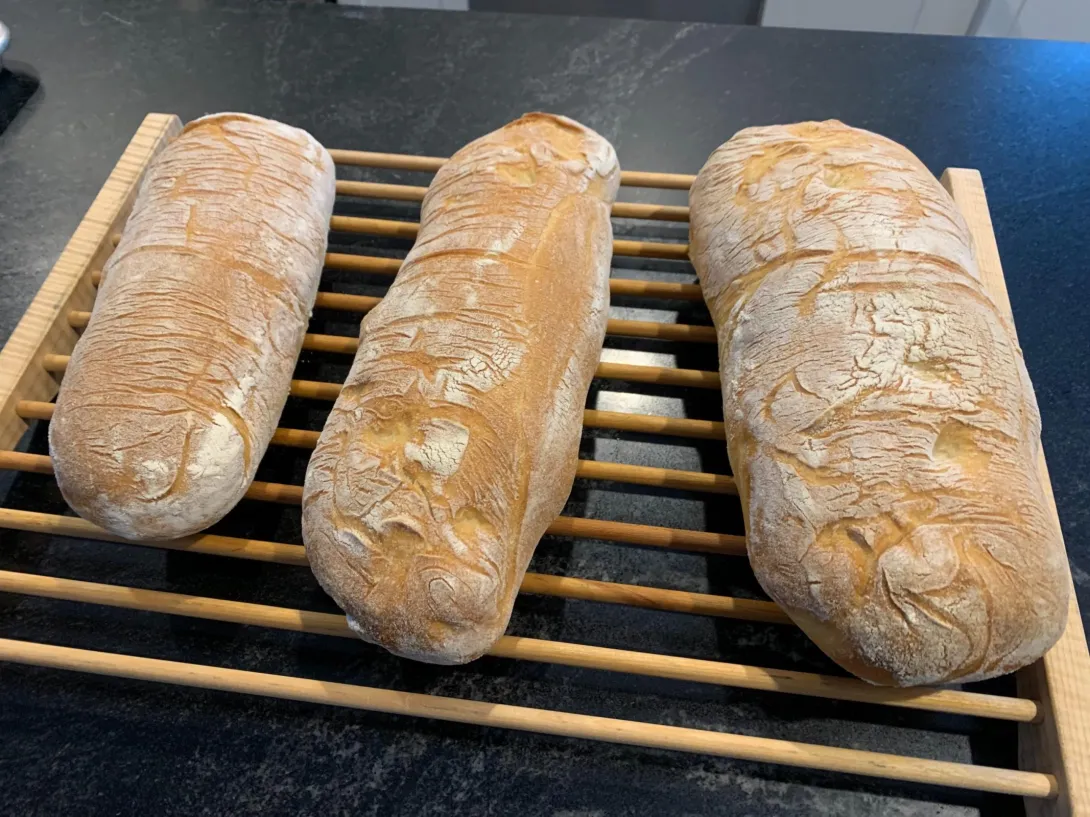
The grandfather of the husband of one of our nieces (nephew-in-law?) died recently and my wife made a meal for his family. I pitched in with ciabatta bread, using Reinhart’s ciabatta with poolish formula from BBA. Since each loaf was a different size, we gave them the Papa Bear and Mama Bear sized loaves.
I did run into one snag with the formula. The final dough calls for 22.75 ounces of flour, which I dutifully mixed in. And immediately began to wonder if I had strayed into a bagel recipe, since the dough was so stiff and dry. A second reading confirmed that I had read the weight quantity correctly but then I noticed that the volume quantity called for 3.5 cups. I suspect a typographical error occurred and that the weight should have been 12.75 ounces, instead.
Cue the addition of water. And more water. And more salt. And more water until, eventually, the dough was the sticky, slack blob that it should have been. Fermentation proceeded pretty much as expected. As much as possible, I avoided degassing the loaves while shaping but I did flip them (deliberately) while transferring them from the couche to a baking sheet. They showed good oven-spring while baking.
The bread was well received. To quote our niece’s husband, “The bread you made is freaking insane.”
Since I haven’t cut into the third loaf, I don’t know what the crumb looks like. It wouldn’t surprise me to find that the texture is closer than a typical ciabatta because of the additional mixing/kneading to incorporate the added water.
Paul
- pmccool's Blog
- Log in or register to post comments
I have the 1st edition, 8th printing. Mine says 3-1/4 cups (22.75 oz) poolish.
Then 3 cups (13.5 oz) flour.
.44 oz, Salt, .17 oz yeast.
3 tbsp to 3/4 cup (3 to 6 oz) water/milk.
I'll post/message a photo if you want.
---
2nd (15th anniversary) edition (Kindle) is as above except: 7.5 oz water/milk.
--
Those are great-looking loaves. Classic ciabatta look.
I really, really need to read more carefully. The book was right. I just read the poolish quantities when I though I was looking at the flour line. Sigh.
Usually, doing something stupid means I get more exercise. This time, it meant that I got a third loaf of bread out of the recipe. So, not a total flop but one I'd rather have done correctly.
Thanks for sending me back for another look.
Paul
It's a hard road to juggle the amounts needed when we realize how off we are at mix time, but it looks as though the experience and knowing the feel of the dough played out in your favor.
My kind of shaping too, long smooth barrels with the minimal amount of raw flour. It's funny how difficult it is to divide ciabatta dough up into fairly even portions by eye and very little way to adjust for it once divided.
Alan
but more careful reading would have prevented the problem. Still, yes, I'm glad I knew what the dough ought to have looked like and how to get from where it was to where it needed to be.
Yeah, I might need to send the Mk 1 eyeball in for recalibration when it comes to dividing the dough. It became obvious pretty quickly that the first cut didn't get a full one-third of the dough but what are you going to do at that point? Ciabatta isn't the most forgiving of doughs, as you note, so I proceeded as if that was what I meant to do. I am happy with the appearance of the finished bread, so we'll call it a success.
Paul
Excellent save Paul, your baker’s instincts saved the bake. These types of errors are too common in cook books, unfortunately it is hard for the editors to pick up on. Then you have less experienced bakers who must follow the recipe and then wonder why it didn’t turn out.
Your ciabattas look amazing, love the crust looking like tree bark.
Benny
I now know the error was with the baker, not with the author. Which, when you think about it, is much better than having an error in the text.
That is a cool look for the crust, isn't it?
Paul
Or "blessing in disguise;" you ended up with more great bread.
The flavor is delightful although, as I anticipated, the crumb isn't nearly as open as we would usually expect from ciabatta. But, hey, holes don't have any flavor, so they aren't really missed.
Paul
…with every mistake we must surely be learning…
nice recovery, too!
Phil
It's the re-learning that chafes. Thank goodness for having the experience to dig my way out of the hole my mistake created.
Paul
Always good when you can recognise something not quite right and save a disaster, well done Paul
I took off making a recipe that I “thought” (if you could call it that) was for 2 loaves, but was actually for 3. Was halfway through the mix when I scratched my head on the quantities…something out of whack. I happened to be copying a batch I’d made purposely to gift a third loaf to my mother-in-law, but I didn’t critically review the quantities until too late into the mix. We get awfully cocky with our yeasty skills and fail to critically or thoughtfully review (or skim) our ingredients and procedure even before mise en place. I guess that pride goes before the fall… Good news is you recovered and I’ll have 3 loaves, not just 2. Hah! Hardly a fatal fall…